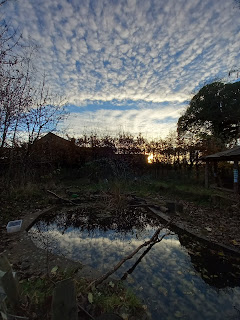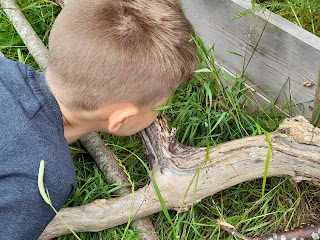Safety First
I spend a lot of time trying to ensure the children are capable of risk assessing for themselves. We do have a comprehensive Risk Assessment as well as a Risk Management document, but once in Forest School, this is of little use to the actual children. It's not something I can read allowed to a group so they understand how to stay safe!
I try to make sure that the children understand the basics. We revisit them each week and most of the school can recite them verbatim! This however can make them routine and something that is said but not necessarily adhered to.
The most basic concept I try to communicate is this:
'Who is the first person to keep you safe in Forest School?'
This at first brings answers such as 'YOU!', or 'the grown ups', or 'the teacher!'.
They're usually shocked when I tell them:
'No. YOU! You are the first person to keep YOU safe!'
'When you see a stinging nettle do you choose to grab it, or do you leave it alone and stay safe?'
'When you see the Brambles do you roll in the prickles or do you walk around them and stay safe?'
'When you dig up rocks do you throw them around and hurt each other or do you move them carefully and keep everyone safe?'
'YOU have choices. The adults cannot be alongside all of you at every given moment. Usually, you only call for us when something already needs sorting out, or if you're in trouble or hurt. YOU can keep yourself safe most of the time.'
The youngest children love this responsibility. As they grow I point out that if you see a friend making a poor choice, or being distracted, you could be a good friend and remind them how to be safe.
This lends itself nicely to ongoing rules, such as safe climbing of trees.
As well as the above rules the children know that their head is THE most important bit of their body when climbing - their eyes to look and their brain to think and plan a way up and a way down.
Each year group tackles different heights, but each is challenging to their abilities, and the rules work for climbing a metre up in an elder bush, or 3 metres in the Mama Beech herself!
I frequently hear children reminding each other of the rules, or asking advice of each other; 'is that branch thicker than my wrist?'
I've even heard children tell others 'Stop talking and concentrate!'
The entire school can chant 'No Lick, No Pick, It will make you Sick!' - even younger siblings tell me this out of school hours!
Tool use needs a lot of reminding, keeping things in their place, and using them correctly as well as safely is the issue that needs the most monitoring. I do explain that the reason we are allowed to do things that could be considered 'dangerous' is because I have to be able to trust them to do the safe thing at all times.
In all honesty, the idea of needing first aid and having to miss part of Forest School is usually incentive enough to comply!
As we frequently have back-to-back sessions, we don't have a 'proper' tidy away routine, but we do count things out, count them back, and leave things tidy. This is ongoing throughout a session.
The very first rule of science is 'DO NO HARM', which is a rule for life really. Whatever equipment, activities, and provision we have outside will have either cost a lot of money or a lot of time. Sometimes it cost both! The natural environment around us is precious and needs to be respected and looked-after, and to be a 'safe' space to explore. Therefore we need to take care of everything and everyone.We model them,
We encourage them.
We repeat them as often as possible.









Comments
Post a Comment